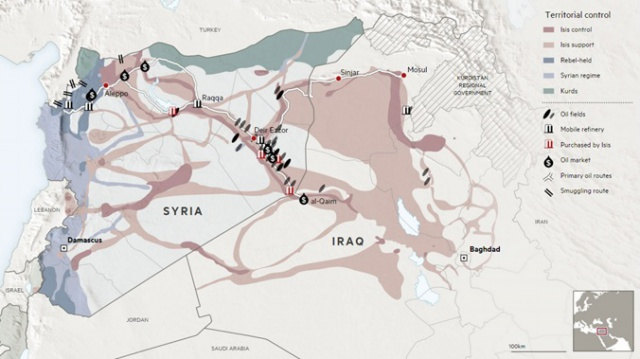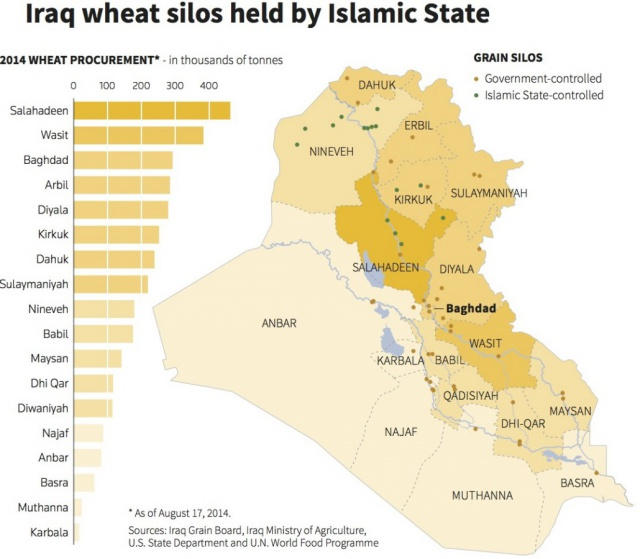Syria ISIS-Daesh Terrorists’ Financing Schemes Unveiled
Part I
In late October, the Committee on the Internal Security of the US Congress published a report on the revenue of various terrorist organizations. Inside Syria Media Center analyzed the documents and compared this information to the facts at our disposal. Please notice that the investigation will be published in several parts.
The analysis of the report shows that organizations like the IS use 7 main sources of income. They include oil and gas, goods like grain, fertilizers, cement, salt, etc. and trading antiquities in the black market. In addition, the other funding sources are racketeering, robbing, kidnapping, aid from the Gulf countries and taxation. The new methods of capital’s management and growth also include criminal activity in Western countries, crowdfunding (2% of the budget), as well as online and charitable Islamic funds’ donations.
Oil trade

Routes of oil supplies from the fields controlled by IS, Financial Times
The report contains peculiar facts and figures confirming the information about the schemes. For example, in early 2016, the IS controlled up to 50% of crude oil production in Syria and up to 10% in Iraq i.e. about 300 oil fields were under ISIS control. At the same time, the terrorists’ revenue in 2015 reached $1 billion with more than $500 million coming from oil trade. According to the US Committee, the same year jihadists produced per day up to 80-120 thousand barrels amounting from $2 to 4 million. It should be noted that 125 terrorist supervisors monitored the work of more than 1,600 oil workers. The IS smuggled oil not only to Turkey but also to customers in Europe via improvised plastic pipelines along the Syrian-Turkish border.

The leading business media using their sources in Iraq and in Washington claim that the Islamic State’s oil revenue totals $40-50 million per month. The main volume is produced on the territory of the Syrian province of Deir ez-Zor.
Agriculture
The data in the document shows that terrorists control up to 400 thousand farmers in Iraq, earning from wheat and barley’s trading up to $200 million per year.

Deliveries of wheat from the areas controlled by ISIS, Reuters
After capturing the fertile territories in the delta of the Euphrates and the Tigris rivers, ISIS captured a vast territory that has brought a significant proportion of Iraqi-Syrian crop. This step aggravated the food security situation in the region.
There is still no precise estimates of the amount of profit earned by the Islamic state from food trade. However a report “Islamic State Financing and US Policy Approaches” (link to the report: PDF) submitted to the US Congress in April 2015, reveals that wheat and barley’s trading at the black market could bring IS an annual income of approximately $200 million (taking into account the fact that ISIS sells its products with a 50% discount).
Some experts point out that the Islamic State is practicing the so-called ‘laundering’ of products by mixing the booty with the yield from other regions to make it difficult to determine their origin. The terrorists also earn money by grabbing farms’ machinery and leasing it to the former owners.
Antiquities trade at the black market
Antique-trade is another source of income. For instance, the IS earns up to $100 million per year for trading antiquities which then “accidentally” appear in London and New York. Actually, terrorists aren’t personally involved in the archeological excavations but issue licenses to the so-called ‘black archeologists’ imposing a tax on their activity (20% in Aleppo, 50% in Raqqa).
According to the American Association of Antiquaries, the main streams of antique smuggling reach Western countries through Lebanon and Turkey, as well as through Saudi Arabia and Qatar. (Link: Looted in Syria – and sold in London: the British antiques shops dealing in artefacts smuggled by Isis). According to various estimates, the total cost of smuggled ancient objects totals about $100 million a year.
Inside Syria Media Center will continue to investigate the other income items of international terrorist organizations. In the next part, we will talk about taxes on the territories controlled by the terrorists, as well as slave trade and donations.
To be continued.

